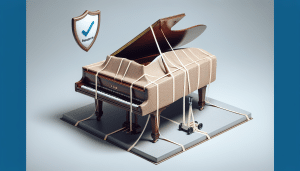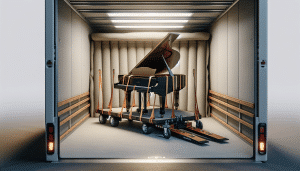Moving a piano is a delicate endeavor, whether you’re dealing with a grand piano, an upright piano, or even a keyboard. Each type of piano has its unique characteristics and challenges when it comes to safe transportation. In this guide, we’ll explore the best practices for moving different types of pianos to ensure they arrive at their destination unharmed.
Grand Pianos
Grand pianos are the epitome of elegance and sound quality. They also happen to be the heaviest and most challenging to move. Here’s how to move a grand piano safely:
1. Gather the Right Equipment
- Piano Board: A sturdy piano board with straps and buckles to secure the piano in place during transport.
- Piano Skid Board: A skid board with casters for easier movement.
2. Disassemble If Necessary
- Remove the legs and pedal lyre, if possible, to make the piano easier to handle.
3. Protect the Piano
- Wrap the piano in thick blankets or padding to prevent scratches or dings.
4. Securely Load the Piano
- With the help of several strong individuals, gently lift the grand piano onto the piano board.
- Ensure it’s securely fastened and properly balanced on the skid board.
5. Move with Caution
- Carefully roll the piano to its destination, ensuring there are no obstacles in the way.
- Take your time and make smooth, controlled movements.
Upright Pianos
Upright pianos are more compact than grand pianos but can still be challenging to move due to their weight and height. Here’s how to move an upright piano safely:
1. Secure the Piano
- Lock the piano keys to prevent them from moving during the transport.
2. Tilt and Slide
- Tilt the piano slightly, so it rests on its back legs.
- Place furniture sliders or a dolly under the piano’s feet.
3. Protect the Piano
- Cover the piano with blankets or padding to prevent any damage.
4. Move with Care
- Slowly slide the piano to its new location, making sure to lift it slightly over any thresholds or uneven surfaces.
Keyboards
Keyboards, especially portable ones, are relatively easy to move compared to grand and upright pianos. However, you still want to ensure they arrive safely and undamaged:
1. Disconnect Cables
- Before moving, unplug and secure any cables or connections.
2. Use a Case or Bag
- If your keyboard has a case or bag, use it for added protection.
3. Secure It in Your Vehicle
- If you’re transporting it in a car, make sure it’s securely placed to prevent it from sliding or moving during the journey.
Conclusion
Whether you’re moving a grand piano, an upright piano, or a keyboard, the key to a safe move is preparation and care. Ensure you have the right equipment, take your time, and enlist the help of others if needed. For grand and upright pianos, it’s often best to hire professional piano movers who have the expertise and equipment to handle these delicate instruments with the utmost care.
At Utah Piano Movers, we specialize in piano transportation, including grand and upright pianos. Contact us at 801-396-7323 or visit our website to schedule your piano move and rest assured that your instrument will be in expert hands.




